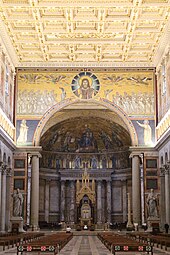An earthquake originating in the Central Apennines was felt in Rome and Spoleto on 29 April 801. It is reported in two independent contemporary sources, Einhard's Royal Frankish Annals and the Liber Pontificalis. The information provided by the written sources has been augmented by archaeology.[1]
Both the Annals and the Liber date the event to 30 April according to contemporary Roman practice, whereby the day began at sundown. The Annals specify that it happened at the second hour of the night, which corresponds to 20:00 (8:00 p.m.) on 29 April by modern reckoning.[1] The Annals record the event from the perspective of the Frankish king Charlemagne, who had been crowned Roman emperor on 25 December 800 and had left Rome on 25 April for Spoleto, where he was staying when the earthquake struck.[2][3] They do not record the damage at Spoleto.[1] Charlemagne was unharmed,[2] but perhaps spooked.[4]

The quake was severe, with an estimated magnitude at Rome of VII–VIII on the modified Mercalli intensity scale and 5.4 on the energy magnitude scale.[1] The epicenter was probably somewhere between Spoleto and Perugia.[5] The Annals refer to its effects throughout Italy, but without specifics. Both sources attest its damage to the roof of the basilica of San Paolo Fuori le Mura in Rome.[1] The archaeologist Rodolfo Lanciani concluded that the damage was even more severe than the sources let on and that Pope Leo III had to rebuild the basilica "from the introit to the presbytery, from the marble floor to the summit of the roof."[6] The Liber mentions the earthquake mainly to introduce Leo III's works at San Paolo, but it leaves the impression that the collapse of the roof caused extensive damage to the interior furnishings (including the silverware stored beneath the altar) and the porticoes.[7] The 5th-century mosaic on the triumphal arch appears to have suffered stylistically from repairs, probably associated with the earthquake of 801.[8] The presbytery was completely rebuilt.[9]
Archaeology has revealed several buildings damaged or destroyed by earthquakes which may have been victims of that of 801.[10] The church of Santa Petronilla on the Via Ardeatina seems to have collapsed entirely in an earthquake, probably that of 801.[5] At that time, it was already abandoned. It had been the burial church of Saints Nereus and Achilleus, but their remains seem to have been transferred inside the city sometime before 801.[11] The remains of Petronilla had been moved to a new shrine in the city in 757 in fulfillment of a promise to Charlemagne's father, Pippin the Short.[12] The Basilica Ulpia also seems to have fallen in an earthquake in about the 9th century. In the case of both buildings, the evidence is also consistent with the earthquake of 847.[10]
The Annals shows that the earthquake caused landslides.[1] It could not have caused a tsunami in the Adriatic, although it has been conflated in some sources with a possible tsunami-causing earthquake of 792 in the northern Adriatic.[13]
- ^ a b c d e f Guidoboni et al. 2018.
- ^ a b Nelson 2019, p. 387.
- ^ Fried 2016, p. 438.
- ^ According to Fried 2016, p. 34, "Charlemagne personally saw earthquakes ... as unmistakable signs of God's wrath."
- ^ a b Cataldi 2022, p. 93.
- ^ Galadini et al. 2018, p. 322.
- ^ Guidoboni et al. 2018 and Camerlenghi 2012, p. 269, based on Liber 98:31, in Davis 1992, pp. 191–192. See also Davis's note 79.
- ^ Davis 1992, p. 192, n. 80.
- ^ Camerlenghi 2018, pp. 130–131.
- ^ a b Galadini et al. 2018, pp. 336–338.
- ^ Guidoboni, Comastri & Traina 1994.
- ^ Nelson 2019, p. 78.
- ^ Guidoboni & Tinti 1988, critiquing Caputo & Faita 1982.
© MMXXIII Rich X Search. We shall prevail. All rights reserved. Rich X Search
